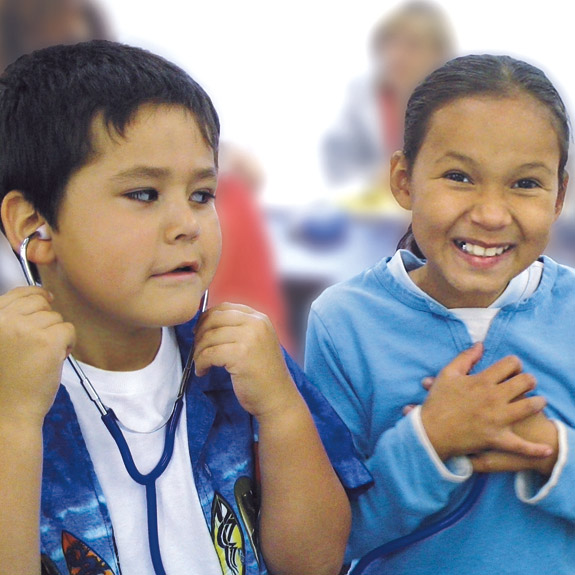On the quirky comedy Northern Exposure, an isolated Alaskan town enticed a New York City doctor to become the community’s physician. While the city doc’s angst and the eccentric residents—including a moose from WSU—drew laughs, the show highlighted a real challenge faced by many small towns and rural areas: recruiting and retaining doctors and nurses.
“There’s a shortage of all health care providers: physicians, nurses, all of the technical programs,” says Gary Smith, a senior project associate with the Area Health Education Center (AHEC) of eastern Washington. “The demand will increase even more when the economy turns around and people want to retire.”

(Photo AHEC Eastern Washington)
AHEC, a division of WSU Extension that works on outreach with the health science programs at WSU Spokane, helps recruit health care providers for rural and underserved populations.
Their mission is increasingly critical. A 2008 University of Missouri study estimated a shortage of 44,000 general practitioners in less than 20 years, a crisis that hits rural areas even harder with their aging population and difficulties in drawing in new health care workers.
In 2005, there were 55 primary care physicians per 100,000 persons in rural areas, compared with 72 in urban areas, according to Mark Doescher, a doctor and director of the University of Washington’s rural health research unit. For registered nurses, the projected number of vacancies eclipses available RNs by 2020.
“It used to be that you had a primary care practitioner, and then you had a general surgeon, and that was kind of the delivery that happened in the rural areas,” says AHEC project associate Bettie Rundlett. “You don’t even have the general surgeons as much anymore.”
Over the last 20 years, the number of health care students in the United States choosing primary care careers in rural areas has declined precipitously due to a number of factors: lower compensation for primary care, professional isolation, limited time off, less specialty support (especially for mental health services), and lack of respect and prestige among peers.
“I think there’s a perception sometimes that the health care you receive in a small community isn’t on a par with a bigger city. Thats absolutely not true from my perspective. A family practice doc who’s out in Grand Coulee or Republic has to deal with everything,” says Rundlett.
AHEC project associate Bonnie Wagner identifies the further challenges of the spouse’s employment and education of their children. “Not only are we asking physicians to go to these rural, isolated, pocketed areas, but we’re also asking them to bring their families,” says Wagner.
Changing demographics in rural Washington add cultural and linguistic challenges to recruitment of doctors and nurses. Despite very good clinical outcomes in rural hospitals, there are still huge health disparities documented within increasing Latino and other ethnically diverse populations.
Rundlett says, “If they don’t have a provider from their same population, they’re less likely to go. That’s one of the things that we try to work on, talking to students from an ethnic minority background to get them better represented in the health care workforce.”
To recruit doctors, nurses, and other health care professionals to rural areas, AHEC’s staff—with state agencies, WSU and other universities, and the communities themselves—use several innovative programs.
Smith says three things are most important in recruiting to rural areas: if the individual is born and raised in a rural community, if any of the practitioners in their internships or residencies spent time in a rural community, and if the community helps to fund some of the education.
One program that covers all three factors enables health care workers to pursue an associate degree in nursing in their home communities. Rural Outreach Nursing Program students study through a combination of distance education and on-site clinical educators, while their employer pays for some of their education. The program started in 2009 with plans to expand to Davenport, Grand Coulee, and other communities.
Educating students from elementary school and up about health care job possibilities is crucial. “Health care is competing against manufacturing and other industries that require less education and get folks into the workforce sooner for a lot of times the same pay,” says Wagner. Project Hope, an education program specifically aimed at Latino and other underserved populations, offers paid high school internships in clinics or hospitals in students’ own communities.
Federal health care reforms also factor into recruitment for rural areas. In the legislation, primary care receives a higher Medicare and Medicaid reimbursement rate for a few years. The reforms also boost the National Health Service Corps, a loan repayment program for health care providers who agree to work in underserved and rural areas.
The Northern Exposure town—played by Roslyn, Washington—drew in its doctor with a loan repayment program, but he grew to love the place. The exposure to the benefits of practice in a rural area can also help retain doctors and nurses. As Smith says, “Getting people out there is the biggest recruitment. Communities have to look good.”
On the web
Just what the doctor ordered: New facilities, high-tech equipment and collaborative care are helping rural hospitals keep medical services close to home. (The Spokesman-Review, July 4, 2010)
